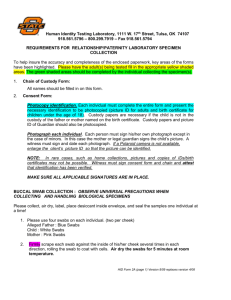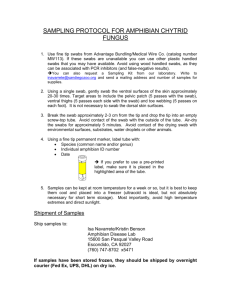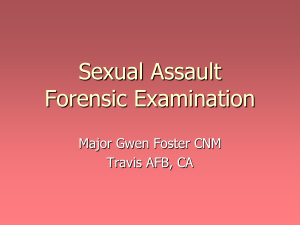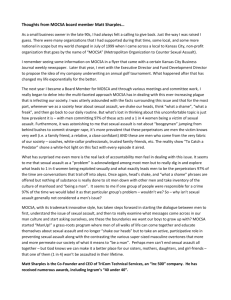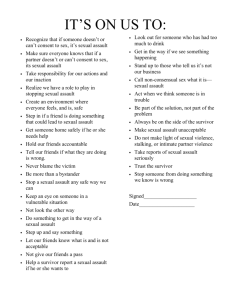Competency Evaluation Tool - Sexual Assault Forensic Examiner
advertisement
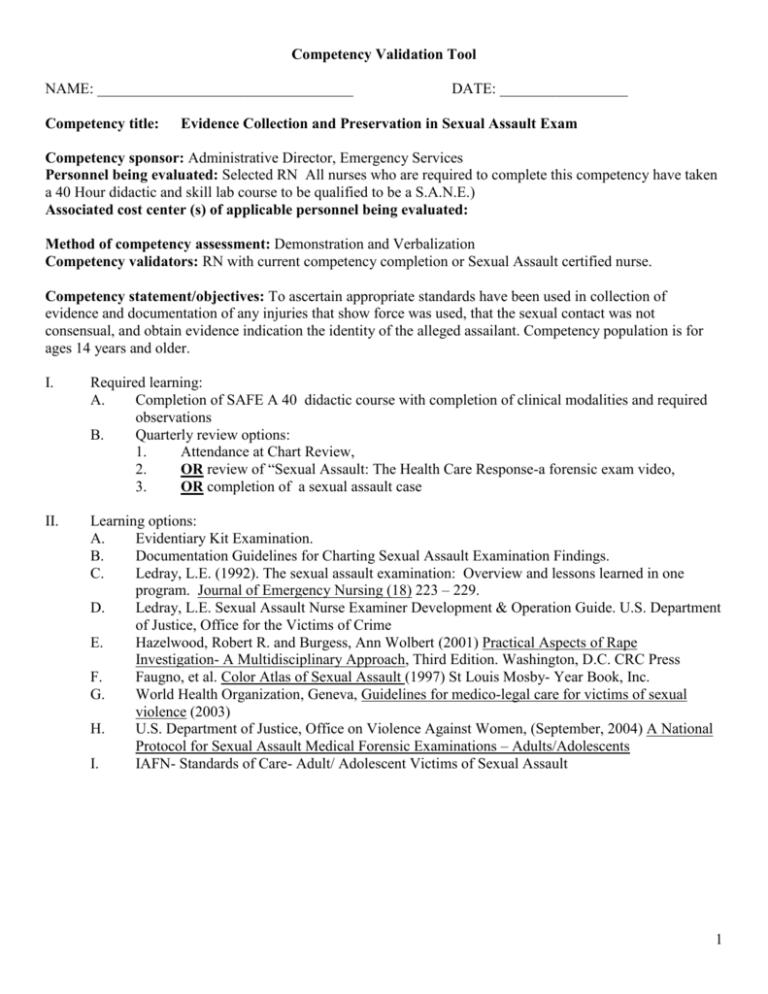
Competency Validation Tool NAME: __________________________________ Competency title: DATE: _________________ Evidence Collection and Preservation in Sexual Assault Exam Competency sponsor: Administrative Director, Emergency Services Personnel being evaluated: Selected RN All nurses who are required to complete this competency have taken a 40 Hour didactic and skill lab course to be qualified to be a S.A.N.E.) Associated cost center (s) of applicable personnel being evaluated: Method of competency assessment: Demonstration and Verbalization Competency validators: RN with current competency completion or Sexual Assault certified nurse. Competency statement/objectives: To ascertain appropriate standards have been used in collection of evidence and documentation of any injuries that show force was used, that the sexual contact was not consensual, and obtain evidence indication the identity of the alleged assailant. Competency population is for ages 14 years and older. I. Required learning: A. Completion of SAFE A 40 didactic course with completion of clinical modalities and required observations B. Quarterly review options: 1. Attendance at Chart Review, 2. OR review of “Sexual Assault: The Health Care Response-a forensic exam video, 3. OR completion of a sexual assault case II. Learning options: A. Evidentiary Kit Examination. B. Documentation Guidelines for Charting Sexual Assault Examination Findings. C. Ledray, L.E. (1992). The sexual assault examination: Overview and lessons learned in one program. Journal of Emergency Nursing (18) 223 – 229. D. Ledray, L.E. Sexual Assault Nurse Examiner Development & Operation Guide. U.S. Department of Justice, Office for the Victims of Crime E. Hazelwood, Robert R. and Burgess, Ann Wolbert (2001) Practical Aspects of Rape Investigation- A Multidisciplinary Approach, Third Edition. Washington, D.C. CRC Press F. Faugno, et al. Color Atlas of Sexual Assault (1997) St Louis Mosby- Year Book, Inc. G. World Health Organization, Geneva, Guidelines for medico-legal care for victims of sexual violence (2003) H. U.S. Department of Justice, Office on Violence Against Women, (September, 2004) A National Protocol for Sexual Assault Medical Forensic Examinations – Adults/Adolescents I. IAFN- Standards of Care- Adult/ Adolescent Victims of Sexual Assault 1 III. Performance criteria: Performance criteria 1. States the first step of evidence collection to include obtaining consent for examination, releasing evidence to police, and taking photographs. 2. States the importance of wearing protective gloves during the entire evidence collection process. 3. States and demonstrates how appropriate chain of custody is maintained for all evidence collected: a. All collected items should have the victim’s name, medical record number, date collected, your initials, and source of specimen. b. Integrity seals should be applied on all evidence by the person collecting the evidence. The collector’s signature should expand across the seal to the envelope or bag. All envelopes should be sealed using sterile water only or affixing a patient label. c. Any evidence once collected that is turned over to another medical or law enforcement personnel needs to have a documented chain of custody for with it containing the signature of the person to whom it was turned over to with the date and time. 4. Describes and demonstrates how clothing is collected and preserved as evidence. a. Places hospital sheet on floor, then paper sheet provided in kit on top of hospital sheet. Has victim stand in center of paper sheet to disrobe, placing each item in a separate paper bag, with the underwear being placed in the “underpants bag” provided in the kit. b. Air dries any wet or damp clothing prior to packaging. c. If victim is wearing clothing that was NOT worn at the time of the alleged assault, only collects items that are in direct contact with victim’s genital area. Ascertains if police are aware of disposition of clothing that was worn at the time of the assault if not with victim. d. Carefully refolds paper sheet when finished Evaluation mechanism Date met/ validator’s initials Interaction Interaction Interaction/ Observation Interaction/ Observation 2 and returns to appropriate evidence envelope from kit. e. Does not shake clothing, does not cut through any holes, rips or stains. f. Air dries any tampon or pad if being used and places in separate paper bag. 5. States techniques used in obtaining photographic Interaction/ Observation evidence. a. All photos should include the victim’s name, medical record number, date, object or area being pictured, and initials of person taking the photo. b. One full length photo and one facial closeup of the victim should be taken for later identification purposes. c. Photograph all areas of injury (bruising, redness, scratches, areas of soreness, and bite marks). Obtain photos from each of the injured areas. Uses a ruler in the photo is possible for verification of size of injury. 6. Demonstrates appropriate techniques and rationale Interaction/ Observation for using a Wood’s lamp and collecting evidence from this technique. a. Wood’s lamp is used to fluoresce fluids, such as saliva, blood, and semen, as well as to identify areas of injury and debris. b. Turns overhead light out, scans each area of the body, exposing one area at a time. c. Any debris (dirt, leaves, fibers, hair, etc.), should be collected, placed into a small folded paper made envelope, then placed in the debris collection envelope provided in the kit. d. Any fluorescing area indicating possible fluid, including any bite marks should be swabbed using the “Double Swab Method” and air dried before placing them in the paper sleeve or envelope. Double Swab Method: The first swab is wet with sterile water then rolled over the surface of the skin. The second swab is not moistened; the same rolling method is used with this swab making sure all the moisture is recovered from the first swab. e. If there is a large amount of crusted material it should be scraped and placed into an envelope rather than swabbing. f. Indicate on the label and the body chart, the location on the victim’s body from which all secretions and debris were collected. 3 7. States cases when finger nail scrapings are performed: a. Victim indicates he/she scratched alleged perpetrator b. Debris is visible under nails c. Crime lab used requests this be done on all victims 8. States importance of pubic hair combings to identify pubic hairs that may have been shed by the alleged assailant during the assault. a. Demonstrates the procedure for performing pubic hair combings. Places towel from pubic hair combings envelope under victims buttocks, using comb provided, combs pubic hair in downward strokes toward towel. Places towel and comb back in appropriate envelope. 9. States process for pulling pubic and head hairs and importance of such to compare with hairs found at the crime scene or on alleged assailants body. a. Does not cut any hairs. Pulls 15 – 20 fulllength pubic hairs from various areas, placing them in the appropriate envelope. b. If a large area of matted pubic hair is noted, it may be cut and labeled as such. c. Pulls at least 5 – 10 full-length head hairs from various locations placing them in the appropriate envelope. 10. Demonstrate proper technique for obtaining oral swabs/smear and saliva sample. a. Does not moisten swabs, uses both swabs simultaneously to the buccal area and gum line then applies smear to slide. Allows swabs and slide to air dry before placing them in the appropriate container, labels all items “oral.” b. DOES NOT stain or chemically fix any smear, always labels slides with pencil rather than pen, as pen may smudge. c. Prior to collection of these swabs, the victim may not eat, drink of smoke for 30 minutes. d. Removes paper disk from Saliva Sample Envelope provided in kit, places folded disk in victims mouth to thoroughly saturate inner circle with their saliva, air dries then places in appropriate envelope being careful to never touch to inner circle if the disk where the saliva is. 11. States and demonstrates the process of vaginal Interaction/ Observation Interaction/ Observation Interaction/ Observation Interaction/ Observation Interaction/ Observation 4 specimen collection and toluidine blue dye application: A total of 4 swabs will be used in the vaginal vault, cervical cuff area. The first two (used simultaneously) will be labeled “vaginal DNA” and the slide prepared from them will be labeled “vaginal DNA.” The second two swabs will be collected in the same fashion with a slide prepared from them only, which will be labeled as “vaginal” only. Does not moisten swabs prior to collecting, allows to air dry completely before packaging. 12. States and demonstrates the process of anal specimen collection: Does not moisten swabs prior to collection, using both swabs simultaneously, swabs the rectal canal. Prepares a slide from swabs, label “rectal”, allows to air dry and package. 13. States process for penile specimen collection: Using double swab method discussed earlier, swabs the entire outer area of the penis and scrotum, where contact is suspected. Prepares a slide, label all items and allows to air dry before packaging. DOES NOT swab inside the penile opening. 14. After pelvic and anal swabs are obtained, states and demonstrates appropriate procedures related to evidence collection and documentation of injuries with photos obtained through use of a colposcope. IV. V. Interaction/ Observation Interaction/ Observation Interaction/ Observation Acceptable performance threshold level: Competency in total is pass/fail; each applicable component of the competency must be completed satisfactorily; not all need to be completed on the same day. Frequency of competency monitoring: Annual Validators Signature/Initials:____________________________________ Validators Signature/Initials:____________________________________ Validators Signature/Initials:____________________________________ Validators Signature/Initials:____________________________________ Date:_________________ Date:_________________ Date:_________________ Date:_________________ 5

